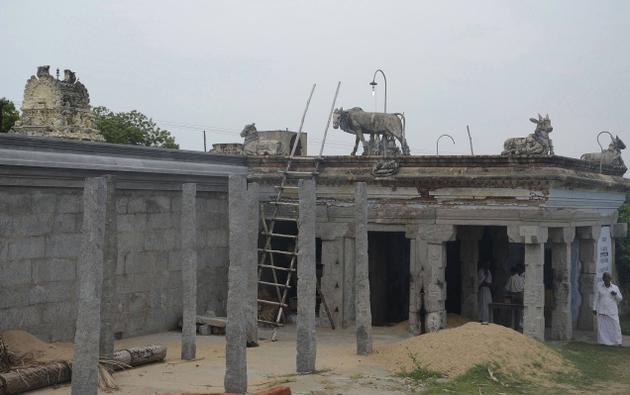Monetary Assistance Required For Temple Rennovation

Chennai, June 27, 2013: Hindu temples in Tamil Nadu bear testimony to the cultural history of the Tamils, the religious fervour of the Tamil kings who built them and the architectural expertise prevalent in the region more than 1,000 years ago. One such temple which speaks volumes of the traditional glory of temple architecture in the state is the Sri Dharma Samvardhiniyammai Udanagiya Sri Thirukkareesanadhar Temple, at Kalavai, about 20 km from Arcot, in Vellore district, and 120 km from Chennai. According to the legend, the presiding deity (of Lord Siva) emerged as a ‘Swayambu’ in the form of a lingam during the seventh century A.D.
Karinayanar, one of the 63 Nayanmars, witnessed a cow shedding milk near an anthill and reported the incident to King Vikrama Chola. When the king came to the spot, he was surprised to see the mound dissolving in rains and uncovering the swayambu lingam within, on hearing the song of Karinayanar. The king built a temple to house the lingam, which came to be known as Thirukkareesanadhar. A statue of the cow, known as ‘Karampasu,’ was installed on top of the front portion of the temple in 1978, when the last kumbabishekam was performed.
Records and inscriptions
The temple abounds in relics and inscriptions (made of ‘pachaikkal’ or green stones), which refer to the period dating back to the later half of the 10th century, the period of Raja Raja Chola, his great grandson Adhirajendra Chola and Kulothunga. There are two records of Vikrama Chola, the son and successor of Kulothunga, dating back to the 12th century. The first one dated 1122 mentions Kalavai as Rajanarayana Chaturvedi Chozhamangalam and the name of the deity as Thirukkarisvaramudaiyar. Historical records have it that Malik Kafur invaded the southern kingdoms in 1310 and looted the temple properties. Kumara Kampana, son of Bukka, who established the Vijayanagara Empire invaded Thondai Mandalam and saw to it that enough grants were given to perform regular pujas in the temple. After the end of the Chola rule, the temple went into the hands of King Krishnadevaraya who sent Thimmappa Nayaka of Sathirappadi on August 20, 1526, to protect the temple. He changed the name of the village as Parimalam, after his daughter. The Arcot Nawab, who was the subsequent ruler, used the temple as a fort.
After the rule of the Nawabs, during whose reign the place got its name Kalavai, the idols were uncovered and the temple was renovated. K.S. Krishnamoorthy, president of the Kalavai Sivanadiyargal Trust, said that the Panchaloka idols of Pradosha Nayagar, Ambal and Durga were stolen in 1999.
The Hindu Religious and Charitable Endowments (HR & CE) Department began the renovation of the temple four years ago. But since the Department did not continue the work, a renovation committee was formed by the local people to carry on the work. Most of the work on rajagopuram has been completed. The vimanam of the sanctum sanctorum was renovated by Sri Sachidananda Swamigal of the Kamalakkanni Adheenam, Kalavai. Krishnamoorthy said that while the estimate for the renovation is Rs. 50 lakhs, works to the tune of Rs.5.5 lakh alone have been completed. The renovation committee has not been able to do much work owing to financial constraints. A further amount of Rs. 25 lakh is required to perform kumbabishekam. Devotees may send their donations by cheque/draft, drawn in favour of Kalavai Sivanadiyargal Trust, addressed to the Trust, 50, Nainar Street, Kalavai-632506, or remit their contributions into the A/c. No.986381471, Indian Bank, Kalavai.
Source: The Hindu, DT. June 27, 2013.







